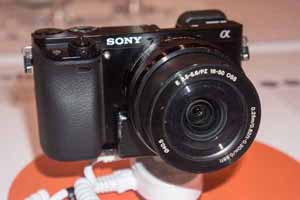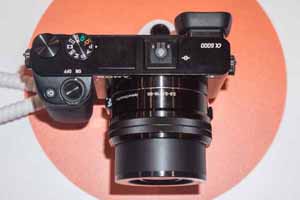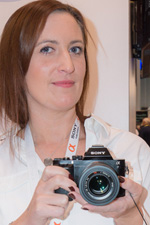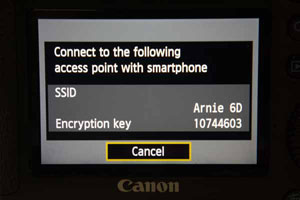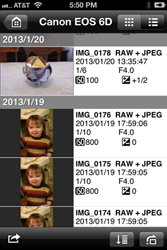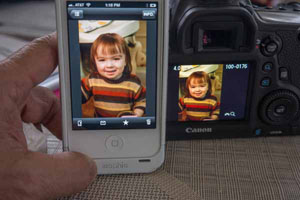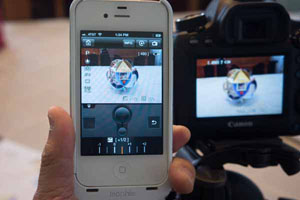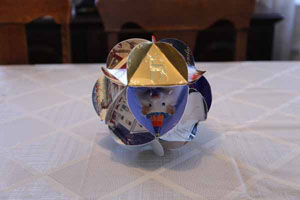Online Magazine
Recent Posts
- Safeguard your Cellphone Photos
- Black & White to Color – Instantly
- Wearing Many Hats
- Video Roundup
- Rescuing Your Blurry Pictures
- Showing Their Age
- What is Your Angle?
- Panorama Photos
- Humorous Photos
- Close Ups
- Fisheye Pictures
- Photo Antiquities
- Printing Big
- Appreciating Scale
- Celebrity Sightings
Tags
More Places to Go
- Free "How-To" Books “How To” books for popular cameras 0
- Vist Us on Facebook keep in touch with us on Facebook 2
Archives
- July 2023 (1)
- March 2023 (2)
- February 2023 (1)
- December 2022 (1)
- October 2022 (1)
- September 2022 (8)
- August 2022 (9)
- July 2022 (1)
- June 2022 (1)
- June 2021 (1)
- May 2021 (1)
- March 2021 (5)
- February 2021 (4)
- January 2021 (2)
- April 2019 (1)
- March 2019 (1)
- February 2019 (1)
- October 2018 (2)
- April 2018 (1)
- March 2018 (4)
- February 2018 (1)
- November 2017 (1)
- August 2017 (1)
- June 2017 (1)
- April 2017 (1)
- March 2017 (5)
- February 2017 (2)
- January 2017 (1)
- October 2016 (1)
- September 2016 (1)
- August 2016 (1)
- July 2016 (1)
- May 2016 (1)
- April 2016 (1)
- March 2016 (2)
- February 2016 (1)
- January 2016 (2)
- December 2015 (1)
- November 2015 (1)
- October 2015 (3)
- April 2015 (1)
- March 2015 (5)
- February 2015 (1)
- January 2015 (4)
- December 2014 (2)
- November 2014 (5)
- October 2014 (2)
- September 2014 (1)
- August 2014 (2)
- July 2014 (1)
- May 2014 (1)
- April 2014 (5)
- March 2014 (5)
- December 2013 (2)
- November 2013 (18)
- October 2013 (1)
- September 2013 (1)
- August 2013 (1)
- July 2013 (1)
- June 2013 (3)
- May 2013 (1)
- April 2013 (2)
- March 2013 (1)
- February 2013 (1)
- January 2013 (1)
- December 2012 (1)
- November 2012 (2)
- October 2012 (2)
- September 2012 (5)
- August 2012 (2)
- July 2012 (1)
- June 2012 (1)
- May 2012 (1)
- April 2012 (4)
- March 2012 (1)
- February 2012 (1)
- January 2012 (3)
- December 2011 (1)
- November 2011 (3)
- October 2011 (1)
- September 2011 (2)
- August 2011 (2)
- June 2011 (3)
- May 2011 (4)
- April 2011 (8)
- March 2011 (8)
- February 2011 (10)
- January 2011 (6)
- December 2010 (11)
- November 2010 (14)
- October 2010 (6)
- September 2010 (12)
- August 2010 (2)
- July 2010 (4)
- June 2010 (3)
- May 2010 (1)
- April 2010 (1)
- March 2010 (2)
- February 2010 (1)
- January 2010 (1)
- December 2009 (1)
- November 2009 (2)
- October 2009 (2)
- September 2009 (1)
- August 2009 (3)
- July 2009 (2)
- June 2009 (1)
- May 2009 (2)
- April 2009 (1)
- March 2009 (2)
- February 2009 (1)
- January 2009 (3)
Sony Alpha 6000
17th April 2014
Sony’s Newest “MILC” – Mirrorless Interchangeable Lens Camera
I’m apolitical when it comes to camera brands. I use equipment from Canon, Nikon, Sony, Olympus, etc.
When traveling for assignments I carry a quality camera and several lenses. For the past few years I’ve gravitated towards the smaller and lighter cameras. What’s more is that lenses for these cameras are also smaller and lighter too so packing is easier.
My go-to camera is now a Sony NEX7 which is half the size and weight of the Canon 6D or Nikon D800. But the one downside of the NEX7 is its slow focusing speed and accuracy in low light situations.
Naturally I was interested in seeing the new Sony A6000 at the Wedding and Portrait Photographers International Expo last month. This new model addresses the focusing issue by using “hybrid” phase detection for fast response combined with contrast detection for improved accuracy. Sony claims that the A6000 can record an amazing 11 frames per second with continuous autofocus. Whether shooting still or video this is a welcome and impressive feature packed into a camera this size and cost.
The A6000 at WPPI was equipped with a 18-50mm lens. Sony calls it a PZ “power zoom” in that it has a small button which automatically zooms in and out when depressed. When retracted this camera/lens combo is quite compact, yet it fits comfortably in my hands. The specs say that the camera body weighs less than 13 ounces – how’s that for a weight saver?
The A6000 has most of the same features of the NEX7 such as in-camera HDR, sweep panorama and multi-frame noise reduction. For me a bonus is the built-in wifi for transferring images to a mobile or computer device and the downloadable apps (for an additional charge) such as time lapse, automatic backup, photo sharing.
The Sony rep told me that the A6000 will be available about April 23rd. Price for the A6000 body is $649; for the A6000 with 18mm-50mm PZ lens is $799.
I have an A6000 on order and am looking forward to this as an upgrade to my NEX7.
Written by: Arnie Lee
PhotoPlus Expo – Sony a7
05th November 2013
Full Frame Mirrorless Interchangeable Lens Camera
At this year’s PhotoPlus Expo, I made it a point to visit Sony’s booth to have a quick hands on their newly announced Alpha 7 camera. But first, here’s a little background that may help to explain why I take such an interest in the a7.
In 2010, Sony introduced the Alpha A55 with its unique translucent mirror. The non-movable mirror enables Sony to pack many innovative features into a space-saving SLT body that are missing from conventional DLSR cameras – accurate and continuous autofocus, real time electronic viewfinder, sweep panorama, multi-frame noise reduction, more. Since then I’ve been a user of two models – the A55 and a more advanced A65. Both produce excellent images. And since they are considerably smaller and lighter than the competitor’s equivalent models, they are less burdensome in the field.
These two SLTs cultivated my fondness for lightweight equipment. So I was very intrigued when I learned about Sony’s NEX series of compact camera. With an APS-C sensor, a NEX camera body is half the size of a DLSR yet accommodates interchangeable lenses owing to its mirrorless design. I soon acquired a lower-end NEX 5 to see if it met my requirements. I found it has image quality but I was not comfortable using the LCD finder with longer lenses. I then purchased the NEX 7 that sports an electronic viewfinder. Since then this has been my camera of choice owing to its excellent image quality, innovative feature set, compact lens size in an extremely lightweight package.
|
|
||
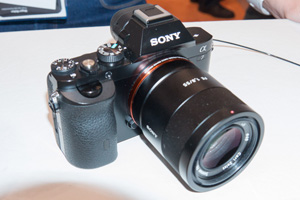 the a7 with Carl Zeiss 55mm f/1.8 lens attached |
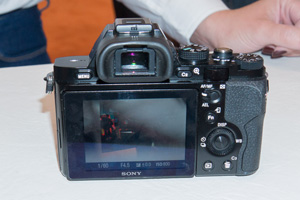 dedicated mode and exposure compensation dials |
|
|
|
||
I am impressed with the small size of the a7. With the 28-70mm lens attached, the package is amazingly small and lightweight. While I wasn’t able to examine my test shots in detail, I’m confident that the full-frame sensor will delivery excellent images. In fact, I understand that Sony supplies this same sensor for use in Nikon’s D600 full frame DSLR.
So I remain in a quandary. Should I move from my very comfortable NEX 7 to this new full-frame a7?
Written by: Arnie Lee
Going Wireless with the Canon 6D
20th January 2013
Earlier this month I visited several of the photo equipment manufacturers at the annual Consumer Electronics Show. Of course the two majors are Canon and Nikon. And while sales by other camera makers including Sony, Olympus, Pentax and Fuji trail by a large margin, new features continue to arrive rapidly among all new models by all manufacturers. This year, one feature that was common in many models is the addition of wireless functionality.
Since CES, I’ve acquired and tested two of the new DLSRs with wireless capabilities: the Canon 6D and the Nikon D600.
Here’s a quick report on how wireless works with the Canon 6D.
There’s nothing earth shattering with this wireless capability. Yes, you can easily transfer images from the 6D to your smartphone and send them via email to others. And yes, it allows for backup, however the images are reduced to a smaller 1920 x 1280 jpg size.
I’ll cover more soon in another article about the Canon 6D’s wireless capability with a computer.
Also in the works is an article about the Nikon D600’s wireless capability.
Written by Arnie Lee
« Older Posts — Newer Posts »
